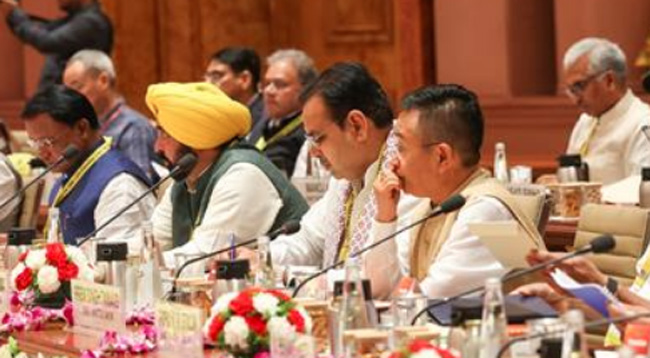New Delhi: Chief Minister Mohan Charan Majhi today appealed for comprehensive support from the Union Government to realize the vision of a “Viksit Odisha for a Viksit Bharat.” Addressing the Governing Council meeting of NITI Aayog, Majhi underscored his government’s commitment to transformative growth, setting ambitious economic targets for the state.
“I seek the support of Government India, under the visionary leadership of Prime Minister Narendra Modi ji, and my counterparts from other States in Odisha’s transformative journey towards Viksit Odisha for Viksit Bharat,” Shri Majhi stated.
Looking ahead to 2036, which marks 100 years since Odisha’s formation, and 2047, the centenary of India’s independence, the Chief Minister presented the state’s “Vision 2036 and 2047” documents. These documents outline a resolve to build “a prosperous, developed, and proud Odisha – a ‘Viksit Odisha’ that shines brightly within a ‘Viksit Bharat.’” The people of Odisha aspire for the state’s economy to reach USD 500 billion by 2036 and further soar to USD 1.5 trillion by 2047.
Shri Majhi highlighted key initiatives undertaken by the new BJP government over the past 11 months, emphasizing a citizen-centric good governance model. “Our government follows a good governance model with citizen-centric policies and programmes. I meet citizens personally and listen to their issues face to face. This is not just a forum – it is a commitment,” he affirmed.
He informed the council about an extensive recruitment drive aimed at filling 150,000 vacant government positions transparently over the next five years. On the fiscal front, Shri Majhi asserted that Odisha has demonstrated strong fiscal discipline and improved the quality of public expenditure to foster economic growth and enhance the quality of life.
The Chief Minister showcased the “Subhadra Yojana” as a “game-changer for women’s empowerment,” noting that over 1 crore women have received more than Rs 10,000 crore directly into their bank accounts, leading to financial and social empowerment. He claimed Odisha’s top ranking in the country with over 16 lakh “Lakhpati Didis” as evidence of the scheme’s success.
Environmental sustainability efforts include the “Ek Ped Maa Ke Naam” campaign, which has seen the planting of over 6.6 crore saplings in the last year with community participation.
In the education sector, Shri Majhi announced the introduction of “Godabarisha Mishra Adarsha Prathamik Vidyalaya,” under which 7,000 elementary schools will be upgraded with advanced infrastructure, learning resources, and life skills education. He also mentioned significant milestones in the implementation of the National Education Policy (NEP) 2020 and the integration of state schemes with Ayushman Bharat-Pradhan Mantri Jan Arogya Yojana, ensuring cashless treatment up to Rs 5 lakhs for over 1 crore families.
During the recently concluded Utkarsh Odisha Conclave, the state received 593 proposals with an investment intent of Rs 16.73 lakh crore across 20 sectors, with a potential to create 12.88 lakh jobs, surpassing the total investment value from the last three conclave editions.
Addressing urban development, the Chief Minister stated, “My Government is committed to provide 40% urbanisation by 2036 & 60% by 2047 from the current 17%. We plan to develop a metropolitan region of 7,000 sq km around Bhubaneswar, Khurda, Jatni, Cuttack, Paradip, and Puri, with similar plans for other growth centers.”
To boost farmers’ incomes and support their agricultural and domestic needs, Majhi’s government has implemented the “CM Kisan” scheme. The state also plans to increase irrigation potential by 15 lakh hectares by 2029-30.
Expressing gratitude to the Government of India for enhancing the cultural significance of Bali Yatra, Shri Majhi concluded by stating, “We plan to have a tie-up with the National School of Drama, New Delhi, to further strengthen celebration of the World’s largest Open-Air theatre-Dhanuyatra in Bargarh.”


